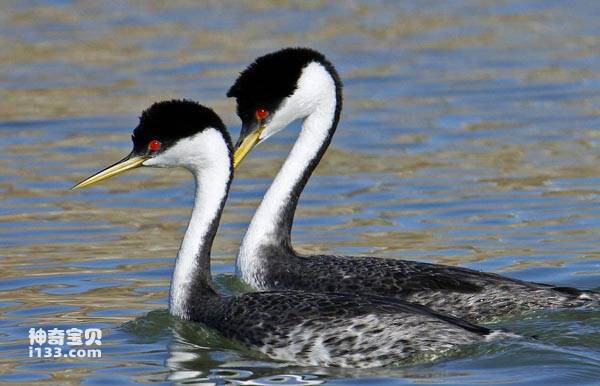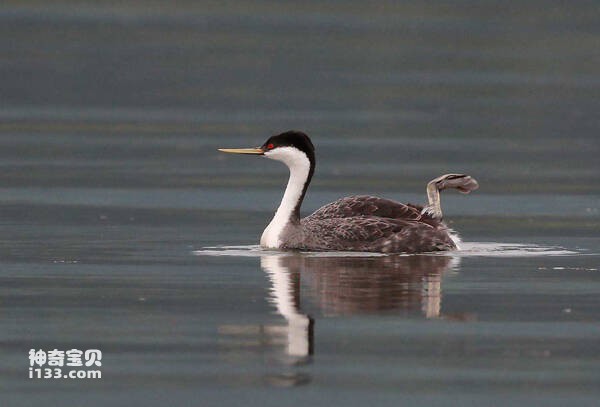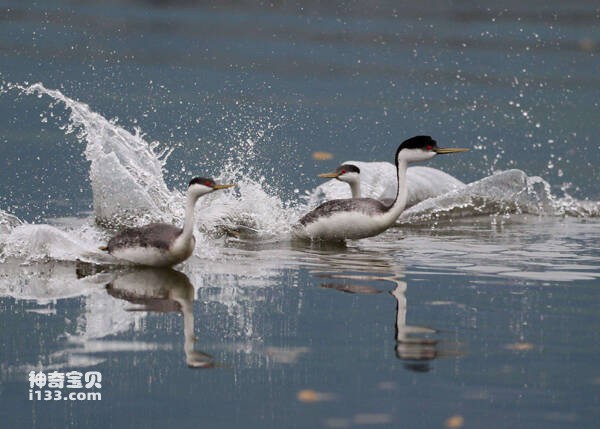Aechmophorus occidentalis
IUCN
LCBasic Information
Scientific classification
- name:Aechmophorus occidentalis
- Scientific Name:Aechmophorus occidentalis,Western Grebe
- Outline:Waterfowl
- Family:
Vital signs
- length:56-74CM
- Weight:About 1.4kg
- lifetime:No textual research information is available
Feature
It is the longest of the Grebe species
Distribution and Habitat
It is distributed in North America, including the United States and Canada, from southeast Alaska to California in the United States, and Chihuahua in northern Mexico. Winter is common in Canada and along the Pacific coast of the United States.
It inhabits lakes, ponds, canals, ponds, and swamps, but is also found in slow-flowing rivers and coastal reed marshes. It is a migratory bird that lives in a freshwater lake of rushes and reeds during the breeding season. It is usually found in the prairie lakes of British Columbia, Canada and California, and sometimes in Mexico. Migrate to the Pacific coast during the winter.
Appearance
The North American grebe is a swimming bird. With a body length of 56 to 74 cm and a weight of 1400 g, it is the longest of the Grebe species. The crown and back of the neck are black, the back is brown-gray, and the lower parts are white, with a dark yellow or olive beak and red eyes surrounded by dark circles. White wing stripes are visible in flight.
The neck is long and thin, and the female is slightly smaller than the male. The mouth is long and yellow-green in color. Mouth straight, lateral flat, with tip; The nostrils are open and located near the base of the mouth; The wings are short, with 12 primary feathers, the first remains, and the fifth secondary feathers missing. The tail has only a few short soft feathers, or almost no feathers. Place your feet near your hips. Flat tarsus, suitable for diving; Each of the four toes has a wide webbed flap; The claws are blunt and broad, the inner edge of the middle toe is serrated, and the back toe is short and higher than the other
Details
The North American Grebe (Aechmophorus occidentalis), Western Grebe, has two subspecies.

The North American grebe spends almost all of its life in the water, often living in clusters, often in pairs or small groups on open water. Not good at flying. They use their feet instead of wings and rarely walk on the ground. It is active during the day, but it is active in the emergent plants or nearby waters during the breeding period, and it hides in the water grass when it meets people. The daytime activity time is longer, from early morning to dusk, almost all in the water, generally do not go to the land. Frequent diving during the activity, each dive time can be up to 30-50 seconds.

North American grebe feeds mainly by diving, usually only 1-4 meters deep. The North American Grebe is a carnivorous water bird that preys on insects, shellfish, fish, and more.

The highlight of the life of a great North American grebe is the difficult, elegant dance of courtship. At this time, the male and female grebe on the water show their love, kiss, gift, feeding, dance, dance to the climax, the North American grebe actually stands up on the water in an incredible position, chasing, walking like flying, galloping distance is usually more than 100 meters. In this way, the female tests the male's strength and loyalty to her. When breeding, they build floating nests in the grass near the water, nesting on the water, made of reeds, weeds and some clay. Eggs produced 2-4, rarely 1-6, eggs light blue or white, mostly stained by dirt. The male and female incubate the eggs in turn. The eggs hatch for about 24 days, and the hatching is not synchronized. The last to hatch may abandon the brood. Chicks are early sex, the whole body is covered with feathers after hatching, the next day can swim and free activity, in the chicks hatched 2-3 weeks, the parent birds often put the chicks on the back, frightened diving they are under the wings. The first flight will take place in 10 weeks. One litter a year.
The North American grebe breeds when food is plentiful. There are usually two to six white or cream colored eggs, incubating for 20 to 30 days, and the nest is usually made of water weeds. Parents often carry their young on their backs, including when diving or in danger. The North American grebe dives for 10 to 40 seconds.
Listed on the International Union for Conservation of Nature (IUCN) 2012 Red List of Threatened Species ver 3.1 - Low Risk (LC).
Protect wild animals and eliminate wild meat.
Maintaining ecological balance is everyone's responsibility!








